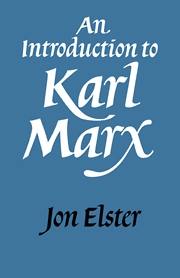Book contents
10 - What Is Living and What Is Dead in the Philosophy of Marx?
Published online by Cambridge University Press: 05 January 2012
Summary
INTRODUCTION
The title of this chapter is adapted from Benedetto Croce's book, What Is Living and What Is Dead in the Philosophy of Hegel? There is little new in it, compared to the preceding chapters. Its task is to dot the i's and cross the t's, so as to provide the reader with a convenient summary. In order to avoid ending on an anticlimactic note, I reverse the order of the title. I first consider the elements of Marx's thought that in my opinion are dead, including some that are artificially kept alive and ought to be buried. I conclude by discussing elements that I consider to be alive, including some that are widely believed to be dead and hence in need of resurrection.
There are several grounds on which one can argue a theory to be dead. First, it may be inapplicable today, even though correct when first stated. Because society changes, statements that were true a hundred years ago may be false today. Second, the theory may have been false even when originally formulated, although by no fault of its author. If his theory was the best that could be stated given the data or the analytical techniques available at the time, one should not blame him if it is superseded in the light of later developments. Third, the theory may have been false at the time of inception, in the light of the available data and techniques.
- Type
- Chapter
- Information
- An Introduction to Karl Marx , pp. 186 - 200Publisher: Cambridge University PressPrint publication year: 1986



